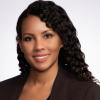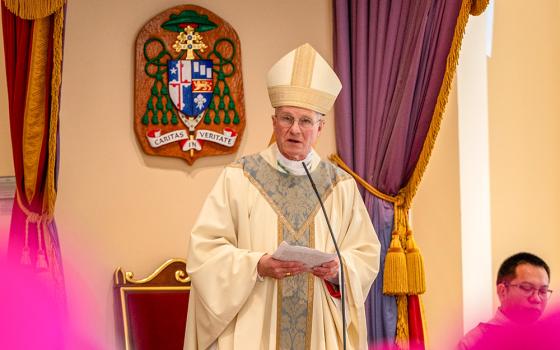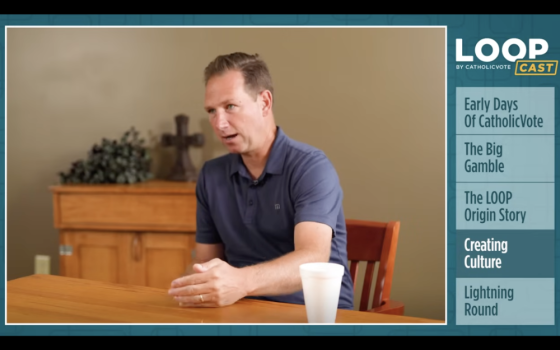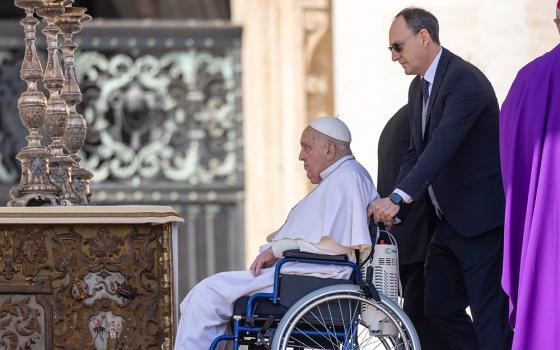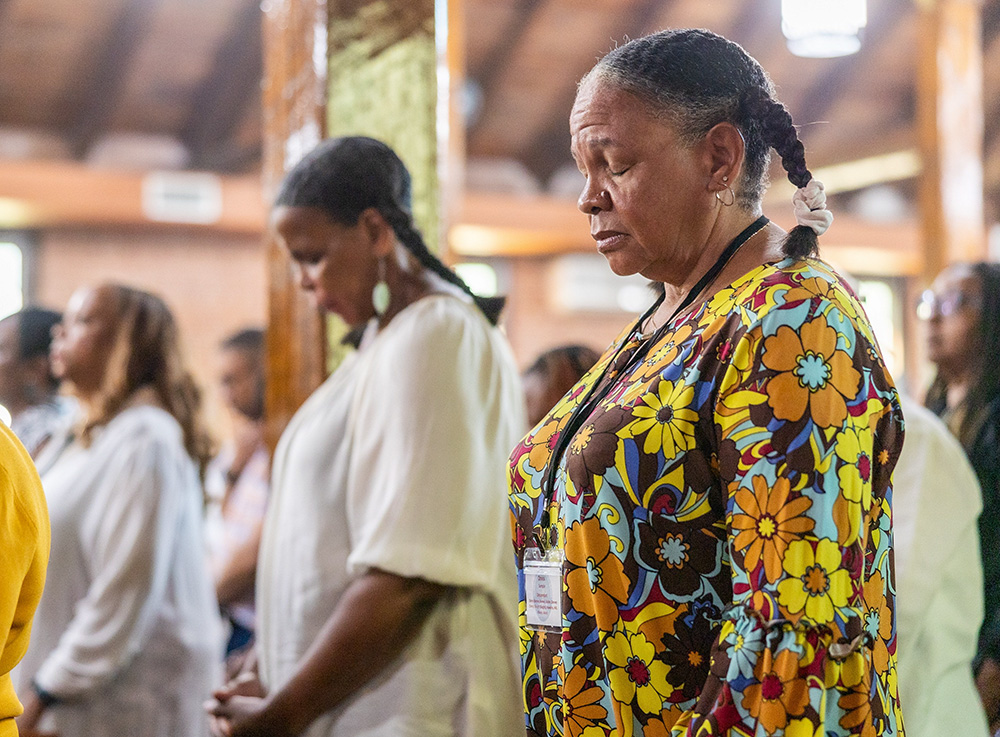
From left, family members Bernadette Semple (in the background), Toni Ann Semple and Denise Semple pray during Mass Sept. 3, 2023, at St. Peter Claver Church in St. Inigoes, Md. The Mass closed the Southern Maryland GU272 — Jesuit Enslaved Descendant Gathering Aug. 31-Sept. 3 that year. (OSV News/Catholic Standard/ Mihoko Owada)
We are living in a time when self-professed Catholics are not only turning a blind eye to evil, but have elected and are supporting President Donald Trump, who is against diversity, against immigrants, against the poor, and seeks to destroy the multiracial democracy that was hard fought and won by the sweat and blood of African Americans and progressives in the United States.
Pope Francis has always directed Catholics to care for immigrants, refugees and foreigners. Yet these exhortations fall on deaf Catholic ears in the United States, a country of foreigners. Aside from Native peoples, all others living on American soil, including European-descended people now considered "white," were once foreigners in this land.
Although America has been known around the world as a beacon of democracy, the reality is that the United States has only been a democracy that included all people since the 1960s. Before that, it was a country that denied people who were not White Anglo-Saxon Protestants (and, at one point, male) the full fruits of citizenship.
In his book The History of Black Catholics in the United States, Cyprian Davis writes that the American Catholic Church found itself "incapable of taking any decisive action or of enunciating clearly thought-out principles regarding slavery."
Advertisement
For centuries, Catholic bishops, priests, laypersons and institutions enslaved Black people. Davis believed this "prevented the American church from playing any serious role until the middle of the twentieth century in the most tragic debate that this nation had to face." The church, instead of being a prophetic voice against the dehumanizing and oppressive sin of slavery, supported the grievous injustice.
Rachel Swarns, New York Times reporter and author of The 272: The Families Who Were Enslaved and Sold to Build the American Catholic Church, wrote about the darker history of the church and America. "For more than a century, the American Catholic Church relied on the buying, selling, and enslavement of Black people to lay its foundations, support its clergy, and drive its expansion. Without the enslaved, the Catholic Church in the United States, as we know it today, would not exist."
The title of Swarns' book refers to the 272 enslaved individuals sold by the Jesuits in leadership at Georgetown University in 1838.
'The Catholic Church in the United States, primarily a white racist institution, has addressed itself primarily to white society and is definitely a part of that society.'
—National Black Catholic Clergy Caucus, 1968
After slavery, white Catholics again chose segregation, violence and oppression over equality. In 1903, a Belgium priest in the Josephite order named Joseph Anciaux wrote a scathing 46-page indictment titled The Miserable Condition of Black Catholics in America with the intention — which was successful — of alerting the Holy See to the dereliction of duty he observed in the U.S. Catholic Church. Summarizing Anciaux's words, Davis writes:
[Anciaux] described the segregation of blacks in Catholic churches, the humiliations of being relegated to the gallery or the side aisles. He went on to speak of the refusal to admit blacks to schools in the South or to any Catholic college or university in the country, with the possible exception, he noted, in most recent times of certain Cuban or Filipino students. ... Making exception for certain of the bishops such as [John] Ireland of St. Paul [Minnestoa], [Antoine] Durier of Natchitoches [Louisiana], and [Francis] Janssens of New Orleans, he knew of no one "who had the boldness to protect or defend openly the rights of blacks."
The disparate treatment of African Americans by Catholic segregationists during Jim Crow apartheid; Catholic parochial schools and universities that would not accept Black students; Catholic homeowners who fought, at times violently, to keep Black people out of their neighborhoods; and the silence of the Catholic institution led the National Black Catholic Clergy Caucus to declare in 1968: "The Catholic Church in the United States, primarily a white racist institution, has addressed itself primarily to white society and is definitely a part of that society."
Robert P. Jones explains in White Too Long: The Legacy of White Supremacy that this anti-Black sentiment among Catholics continued to the late 20th century, when Irish, Italian, French, Spanish, Polish and other non-Black Catholics "had been admitted into the ranks of white Christianity, with all the rights, privileges, and white supremacist expectations thereof." The Catholics brought their anti-abortion stance and a "particularly northern and urban brand of white supremacy." In exchange, their new allies, the Protestant Christian right, allowed them admittance into the "categories of whiteness and mainstream Christianity."
It was only with the passage of Civil Rights legislation like the Equal Pay Act of 1963, Title VII of the Civil Rights Act of 1964, the Voting Rights Act of 1965, the Age Discrimination in Employment Act of 1967 and the Fair Housing Act of 1968 that discrimination against people based on color, gender, religion or age was banned. The country legally turned against racism and toward accepting diversity.
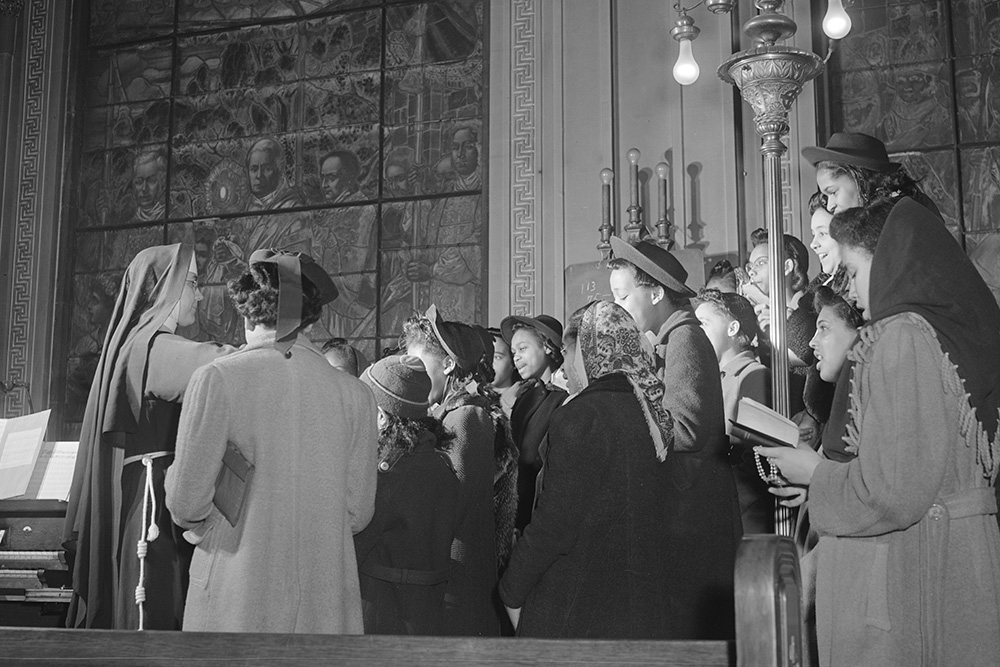
Young people sing in the choir loft of Corpus Christi Church, a predominantly black Catholic parish, in Chicago in 1942. (Library of Congress/Jack Delano)
Steps like implementing affirmative action in prestigious universities that once banned Black Americans; diversity, equity and inclusion trainings to teach people about acceptance; and initiatives to diversify the workforce sought to remedy the centuries of anti-Black racism and give all people, including women, those who are disabled or LGBTQIA+, a chance to succeed in America on equal footing with white males.
Yet the sins of racism and intolerance are rearing their ugly head again in Trump White House 2.0. Trump has made it clear that "Make American Great Again" really means "Make America White Again." By enacting sweeping mass deportations of mostly brown-skinned immigrants, banning "DEI," firing federal workers and rescinding protections against discrimination and civil rights, Trump's administration is trying to ethnically cleanse America.
With 59% of white Catholics voting Trump into office — and the failure of the U.S. Conference of Catholic Bishops to strongly condemn Trump's racist and anti-immigrant agenda — the Catholic Church is once again siding with white supremacy or hoping to benefit from its proximity to whiteness at the expense of people who are Black, Native, noncitizens and LGBTQIA+.
The current times call for us to have a godly vision for our country and throw off what Frederick Douglass called "the garb of Christianity." Let us disrobe ourselves of evil in all its forms of racism, nationalism, homophobia, ableism and misogyny, too often cloaked in religious rhetoric and preached as an anti-gospel.
For when we stand with the poor, the minority, the marginalized, the immigrant and reject the pursuit of power, wealth and superiority over others, we are truly following Jesus Christ. Let us only seek to be justified in the eyes of God, who directs our steps on the path of truth, justice and mercy in our universal church.
